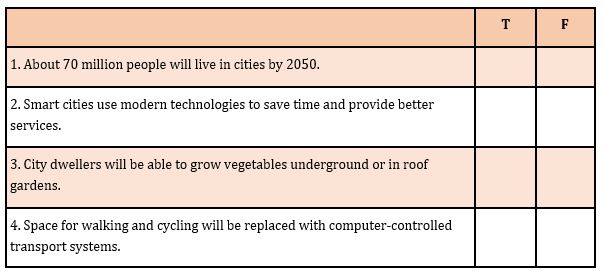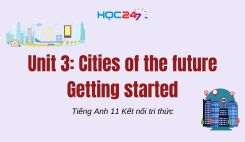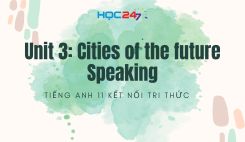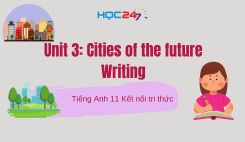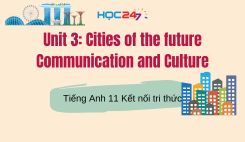Thành phố trong tương lai sẽ như thế nào? Liệu có phải là thành phố với công nghệ hiện đại, thân thiện với môi trường hay không? Để trả lời những câu hỏi ấy, HOC247 xin giới thiệu đến các em học sinh vào nội dung chi tiết bài học Unit 3 Tiếng Anh lớp 11 Kết nối tri thức phần Reading.
Tóm tắt bài
1.1. Unit 3 lớp 11 Reading Task 1
Work in groups. Discuss the questions.
(Làm việc nhóm. Thảo luận các câu hỏi.)
1. What will future cities look like?
(Các thành phố trong tương lai sẽ như thế nào?)
2. Do you think they will be ‘smarter’ and more sustainable? Why/Why not?
(Bạn có nghĩ rằng chúng sẽ 'thông minh hơn' và bền vững hơn không? Tại sao/Tại sao không?)
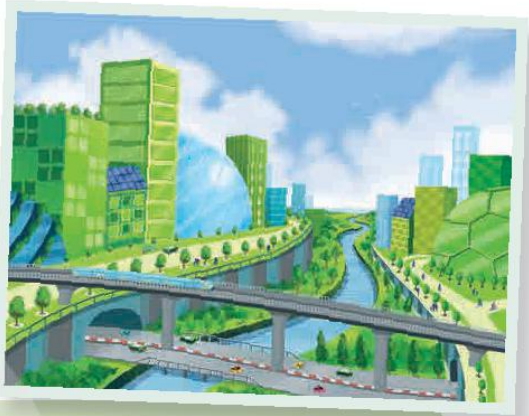
Guide to answer
1.
Future cities are likely to be more technologically advanced and densely populated than they are today.
(Các thành phố trong tương lai có thể sẽ có công nghệ tiên tiến hơn và đông dân cư hơn so với hiện nay.)
They may also be more sustainable, with green spaces and renewable energy sources.
(Chúng cũng có thể bền vững hơn, với không gian xanh và các nguồn năng lượng có thể tái tạo.)
There may be a greater focus on public transportation and walkability, rather than car-centric design.
(Có thể có sự tập trung nhiều hơn vào giao thông công cộng và khả năng đi bộ hơn là thiết kế tập trung vào ô tô.)
2.
Yes, I think future cities will be smarter and more sustainable.
(Vâng, tôi nghĩ các thành phố trong tương lai sẽ thông minh hơn và bền vững hơn.)
Technology will play a key role in optimizing resource usage, reducing waste, and improving efficiency.
(Công nghệ sẽ đóng một vai trò quan trọng trong việc tối ưu hóa việc sử dụng tài nguyên, giảm rác thải và nâng cao hiệu quả.)
There is also a growing awareness of the need to reduce our impact on the environment, and sustainability will be a key consideration in urban planning and development.
(Ngoài ra còn có nhận thức ngày càng tăng về nhu cầu giảm tác động của chúng ta đối với môi trường và tính bền vững sẽ là yếu tố chính được xem xét trong quy hoạch và phát triển đô thị.)
1.2. Unit 3 lớp 11 Reading Task 2
Read the article. Circle the correct meanings of the highlighted words and phrases.
(Đọc bài báo. Khoanh tròn nghĩa đúng của các từ và cụm từ được làm nổi bật.)
|
By 2050 the world’s population is expected to reach 10 billion, and nearly 70 per cent of these people will live in cities. The cities of the future wili be ‘smarter’ and more sustainable to cope with a growing population and improve people’s lives. A smart city is amodern urban area that uses a range of technologies to provide services, solve problems, and support people better. The new technologies can help save time by predicting changes in the traffic and warning people of possible traffic jams. They will also help cities operate more efficiently. For example, street lights can turn off when the streets are empty, and sensors can inform waste collection teams when the bins are full. These smart technologies will help save energy, reduce air pollution, and fight climate change. Cities in the future will also be sustainable. They will include a lot of green space and become home to more plants and animals. Making room for biodiversity and nature can be done in various ways including underground and rooftop farming, green roofs, and roof gardens. As people will care more about the environment, most cities will use renewable and clean energy. Modern infrastructure will also be more eco-friendly. Computer-controlled transport systems like electric buses and trains will produce less greenhouse gas emissions. In addition, more pedestrian zones for walking and cycle paths will be made available for people in all neighbourhoods. These features will make future cities more liveable and will provide a high quality of life to city dwellers. |
1. operate more efficiently
A. to work better without wasting time, money, or energy
B. to control a machine without wasting resources
C. to cut a body open for medical reasons in a more careful way
2. sensors
A. devices that can react to light, heat, or pressure
B. instruments that can be played by people
C. devices for discovering rubbish
3. pedestrian zones
A. areas for cars only
B. areas for electric buses
C. areas for walking only
4. liveable
A. suitable for farming
B. nice to live in
C. good for the environment
Guide to answer
1 - A. operate more efficiently: to work better without wasting time, money, or energy
(hoạt động hiệu quả hơn: làm việc tốt hơn mà không lãng phí thời gian, tiền bạc hoặc năng lượng)
2 - A. sensors: devices that can react to light, heat, or pressure
(cảm biến: thiết bị có thể phản ứng với ánh sáng, nhiệt hoặc áp suất)
3 - C. pedestrian zones: areas for walking only
(khu vực dành cho người đi bộ: khu vực chỉ dành cho người đi bộ)
4 - B. liveable: nice to live in
(có thể sống được)
1.3. Unit 3 lớp 11 Reading Task 3
Read the article again and decide whether the statements are true (T) or false (F).
(Đọc bài báo một lần nữa và xem những câu phát biểu là đúng (T) hay sai (F).)
Tạm dịch
1. Khoảng 70 triệu người sống ở thành phố vào năm 2050.
2. Thành phố thông minh sử dụng công nghệ hiện đại để tiết kiệm thời gian và cung cấp dịch vụ tốt hơn.
3. Cư dân thành phố sẽ có thể trồng rau dưới đường hầm hoặc vườn trên mái nhà.
4. Không gian cho đi bộ và đạp xe sẽ bị thay thế bằng hệ thống giao thông điều khiển bằng máy tính.
Guide to answer
1 - F
Thông tin: By 2050 the world’s population is expected to reach 10 billion, and nearly 70 per cent of these people will live in cities.
(Đến năm 2050, dân số thế giới dự kiến sẽ đạt 10 tỷ người và gần 70% trong số này sẽ sống ở các thành phố.)
2 - T
Thông tin: A smart city is amodern urban area that uses a range of technologies to provide services, solve problems, and support people better.
(Thành phố thông minh là một khu đô thị hiện đại sử dụng nhiều công nghệ để cung cấp dịch vụ, giải quyết vấn đề và hỗ trợ người dân tốt hơn.)
3 - T
Thông tin: Making room for biodiversity and nature can be done in various ways including underground and rooftop farming, green roofs, and roof gardens.
(Tạo không gian cho đa dạng sinh học và thiên nhiên có thể được thực hiện theo nhiều cách khác nhau bao gồm canh tác dưới lòng đất và trên mái nhà, mái nhà xanh và vườn trên mái.)
4 - F
Thông tin: In addition, more pedestrian zones for walking and cycle paths will be made available for people in all neighbourhoods.
(Ngoài ra, nhiều khu vực dành cho người đi bộ dành cho đi bộ và đi xe đạp sẽ được cung cấp cho người dân ở tất cả các khu vực lân cận.)
1.4. Unit 3 lớp 11 Reading Task 4
Read the article again and complete the diagram with information from the text. Use no more than TWO words for each answer.
(Đọc bài viết một lần nữa và hoàn thành sơ đồ với thông tin từ văn bản. Sử dụng không quá HAI từ cho mỗi câu trả lời.)
Smart
* Modern technologies are used to (1) ____________ people better.
* Smart devices help cities (2) ____________ more efficiently.
Sustainable
* Cities will include a lot of (3) ___________ and become home to more plants and animals.
* Eco-friendly (4) ___________ will reduce greenhouse gas emissions.
Guide to answer
1 - support
2 - operate
3 - green space
4 - transport systems
Smart (Thông minh)
* Modern technologies are used to (1) support people better.
(Các công nghệ hiện đại được sử dụng để hỗ trợ con người tốt hơn.)
* Smart devices help cities (2) operate more efficiently.
(Các thiết bị thông minh giúp các thành phố hoạt động hiệu quả hơn.)
Sustainable (Bền vững)
* Cities will include a lot of (3) green space and become home to more plants and animals.
(Các thành phố sẽ có nhiều không gian xanh và trở thành nơi sinh sống của nhiều loài thực vật và động vật hơn.)
* Eco-friendly (4) transport systems will reduce greenhouse gas emissions.
(Hệ thống giao thông thân thiện với môi trường sẽ giảm phát thải khí nhà kính.)
1.5. Unit 3 lớp 11 Reading Task 5
Work in groups. Discuss the following questions.
(Làm việc nhóm. Thảo luận các câu hỏi sau.)
Would you like to live in a smart and sustainable city? Why/Why not?
(Bạn có muốn sống trong một thành phố thông minh và bền vững hay không? Tại sao có? / Tại sao không?)
Guide to answer
Yes, I would like to live in a smart and sustainable city because it would provide me with a better quality of life. I believe that the use of modern technologies and eco-friendly infrastructure would make the city more efficient, reduce pollution, and provide more green spaces.
Tạm dịch
Có, tôi muốn sống trong một thành phố thông minh và bền vững vì nó sẽ mang lại cho tôi chất lượng cuộc sống tốt hơn. Tôi tin rằng việc sử dụng các công nghệ hiện đại và cơ sở hạ tầng thân thiện với môi trường sẽ giúp thành phố hoạt động hiệu quả hơn, giảm ô nhiễm và cung cấp nhiều không gian xanh hơn.
Bài tập minh họa
Choose the correct word to fill in the blanks.
(Chọn từ thích hợp để điền vào chỗ trống.)
sustainable / intelligence / underground / vehicles / quality
| In the future, cities may see flying (1) ______ mega bridges, super-connected street experiences, and (2) ______ spaces. Those futuristic cities will be powered by big data, the Internet of Things, and artificial (3) ______ – so they may live, breathe, and even think with us. But other aspects of the futuristic city include (4) ______ , inclusive, and mixed-use. Technology will also be used to create a new (5) ______ of life in well-planned developments that don’t lose the human touch. |
Key
1. vehicles
2. underground
3. intelligence
4. sustainable
5. quality
Luyện tập
3.1. Kết luận
Qua bài học này các em cần ghi nhớ các từ vựng sau:
- be densely populated: đông dân
- sustainable: bền vững
- operate more efficiently: vận hành hiệu quả hơn
- sensor: cảm biến
- pedestrian zones: khu vực dành cho người đi bộ
- liveable: có thể sống được
- support: hỗ trợ
- green space: không gian xanh
- greenhouse gas emissions: khí thải nhà kính
- eco-friendly: thân thiện với môi trường
3.2. Bài tập trắc nghiệm Unit 3 - Reading
Như vậy là các em đã xem qua bài giảng Unit 3 - Reading chương trình Tiếng Anh lớp 11 Kết nối tri thức. Để củng cố kiến thức bài học mời các em tham gia bài tập trắc nghiệm Trắc nghiệm Unit 3 lớp 11 Kết nối tri thức Reading - Đọc hiểu.
-
- A. beating myself up
- B. making up my mind
- C. picking myself up
- D. giving myself up
-
Câu 2:
Choose the answer that has different stress from the others: festival, summary, selection, holiday
- A. festival
- B. summary
- C. selection
- D. holiday
-
- A. I lose my contact lenses when I was on the plane.
- B. I lost my contact lenses which was on the plane.
- C. When I lost my contact lenses on the plane.
- D. I had lost my contact lenses on the plane.
Câu 4-10: Mời các em đăng nhập xem tiếp nội dung và thi thử Online để củng cố kiến thức về bài học này nhé!
Hỏi đáp Unit 3 - Reading Tiếng Anh 11
Trong quá trình học tập nếu có thắc mắc hay cần trợ giúp gì thì các em hãy comment ở mục Hỏi đáp, Cộng đồng Tiếng Anh HOC247 sẽ hỗ trợ cho các em một cách nhanh chóng!
Chúc các em học tập tốt và luôn đạt thành tích cao trong học tập!
-- Mod Tiếng Anh 11 HỌC247


